重大版选修8 Unit 2 Non-verbal Communication Reading(共54张PPT)
文档属性
| 名称 | 重大版选修8 Unit 2 Non-verbal Communication Reading(共54张PPT) | 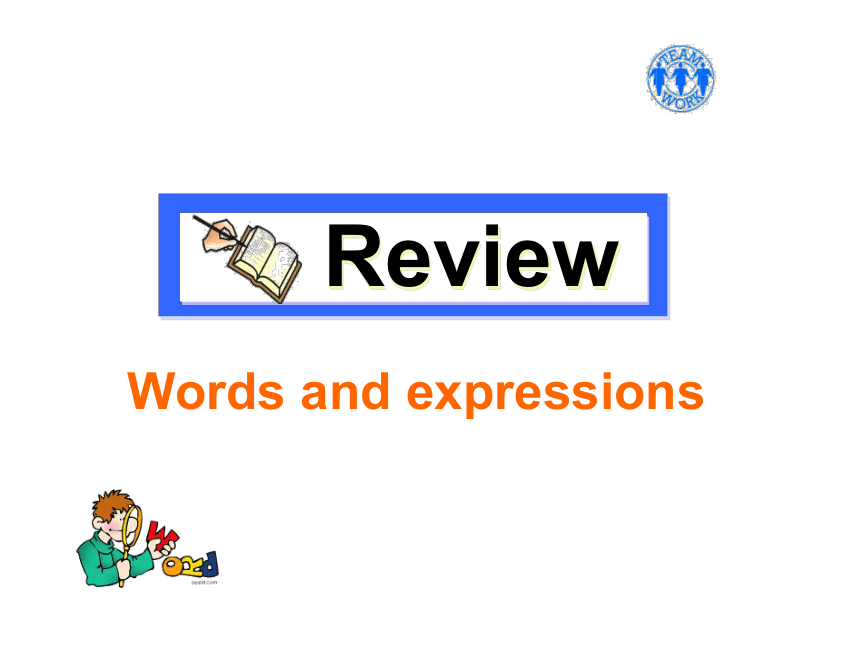 | |
| 格式 | zip | ||
| 文件大小 | 3.3MB | ||
| 资源类型 | 教案 | ||
| 版本资源 | 重庆大学版 | ||
| 科目 | 英语 | ||
| 更新时间 | 2015-03-20 15:48:19 | ||
图片预览



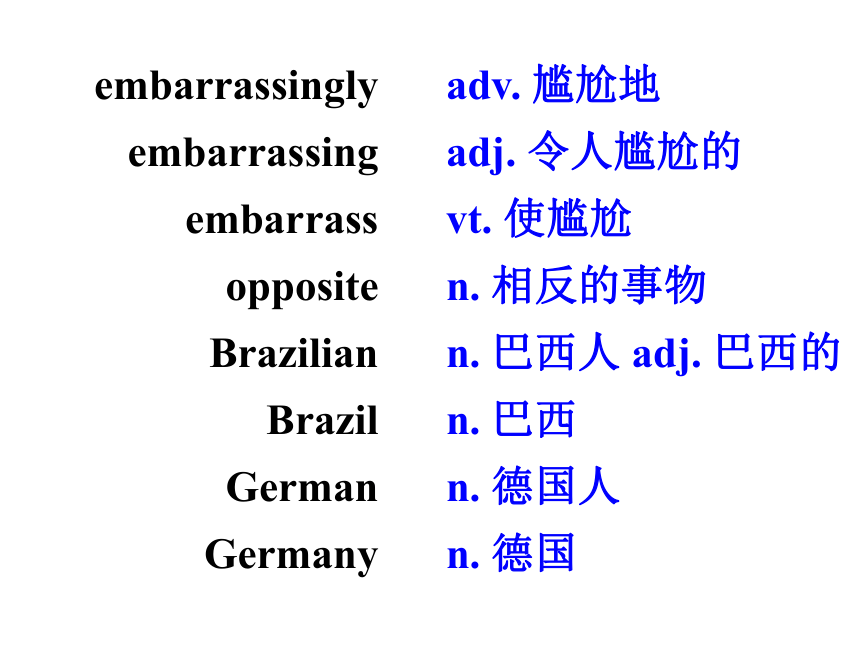
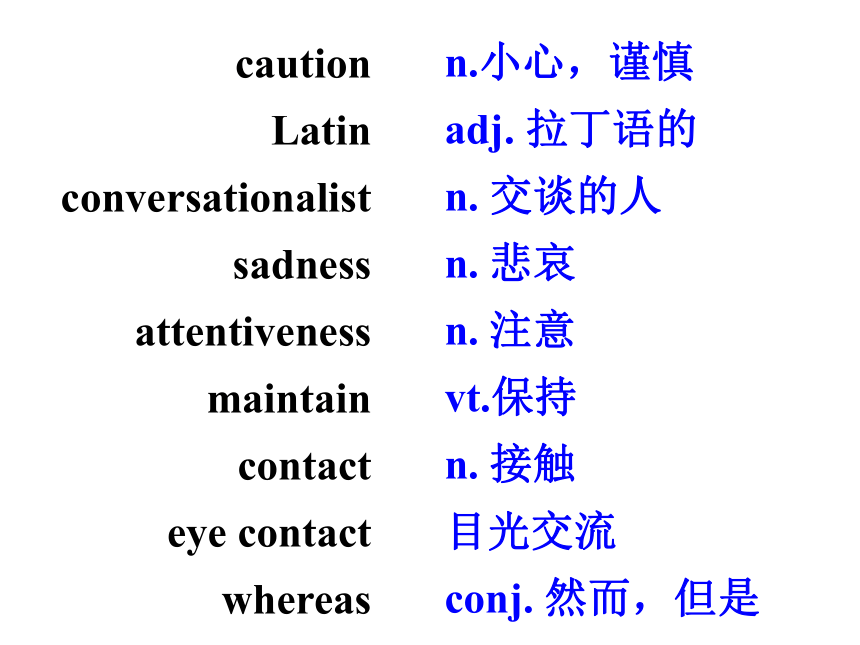
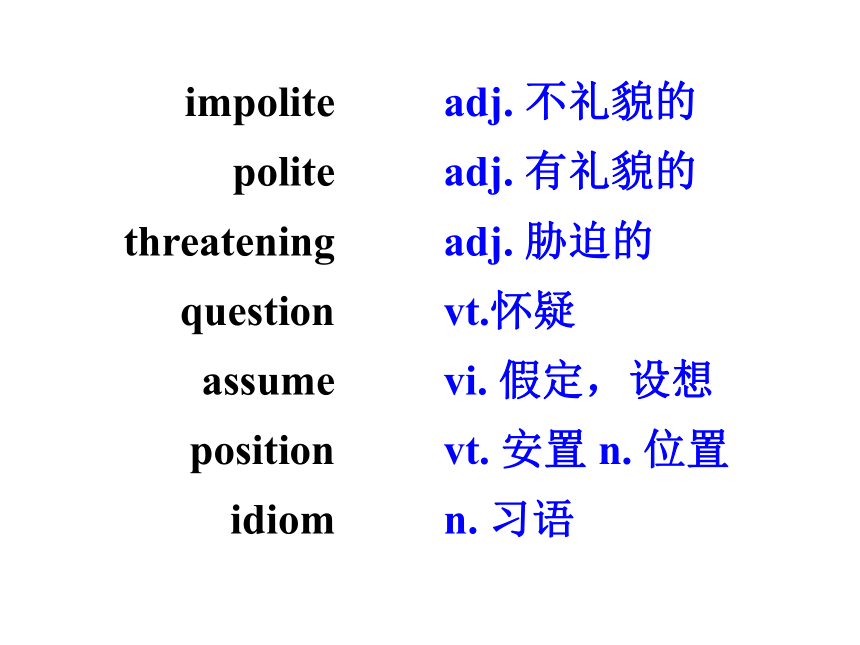
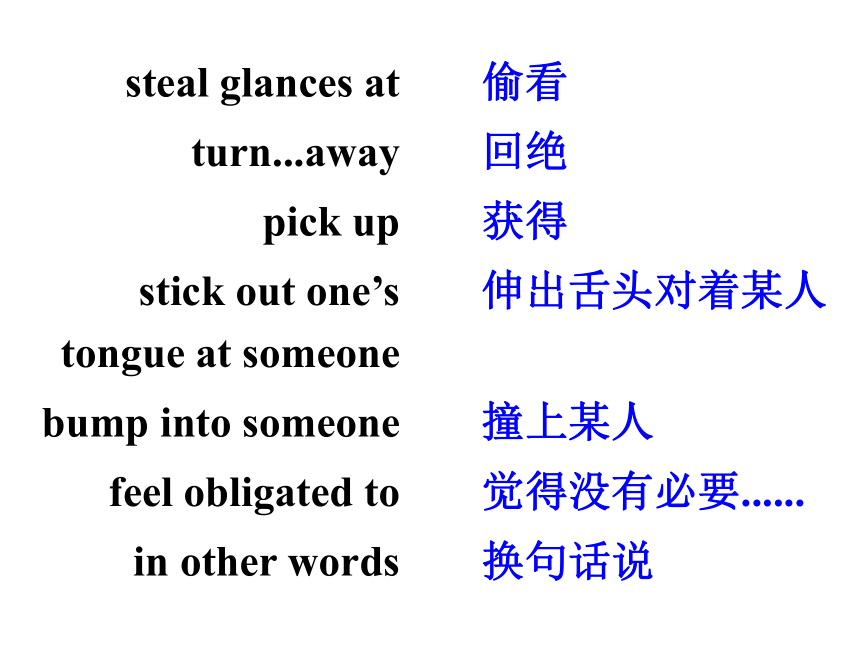
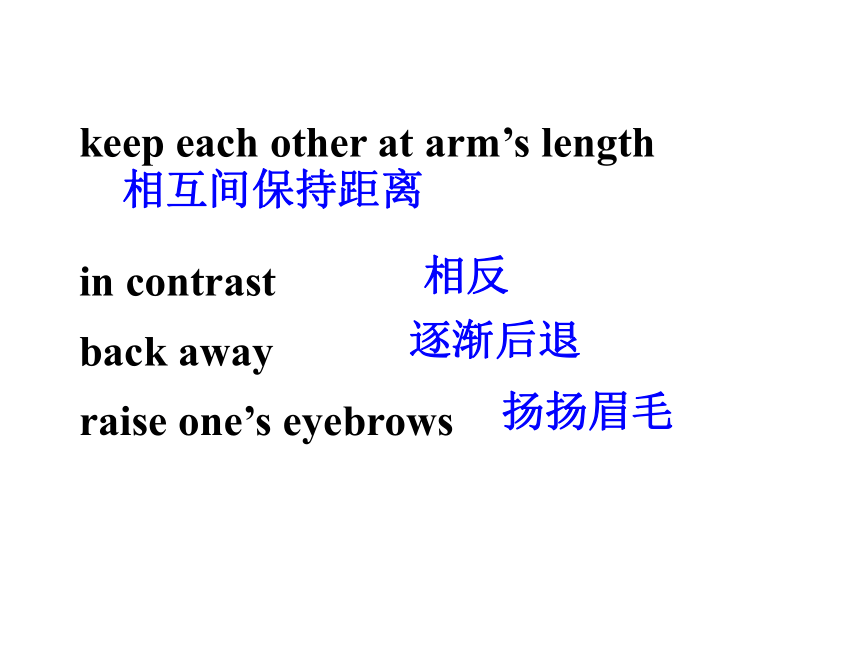

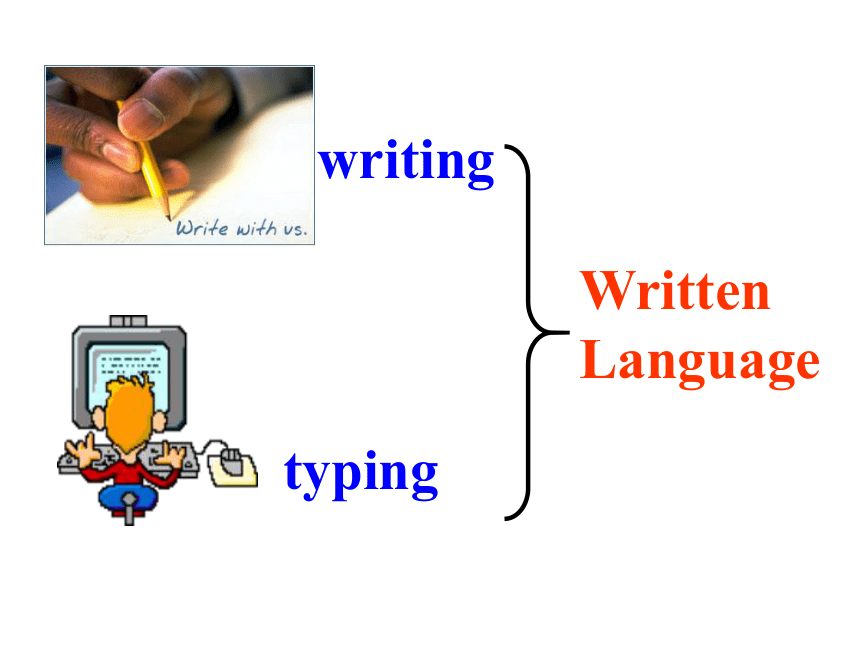
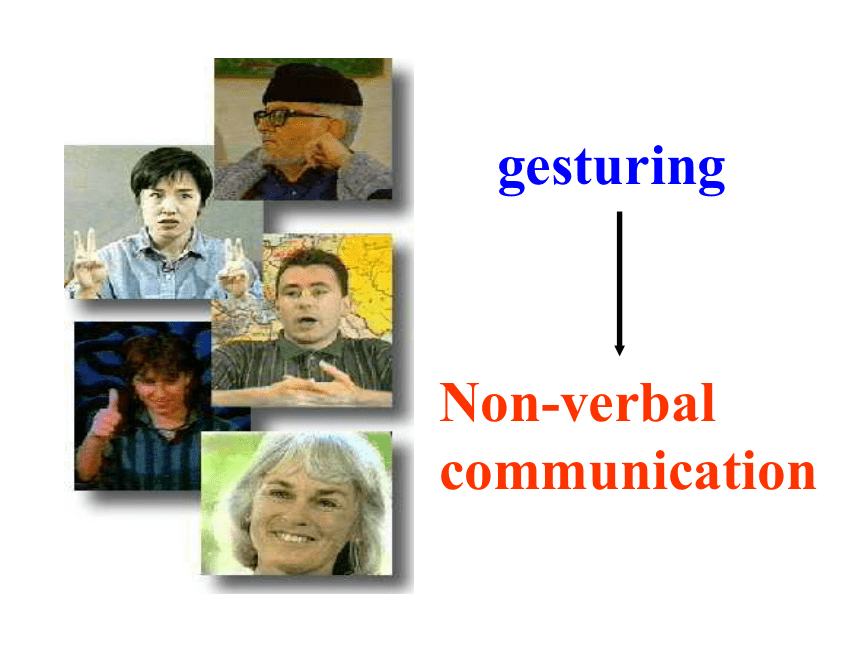

文档简介
课件54张PPT。ReviewWords and expressions单词回顾学生早读时已预习过本单元单
词,可利用几分钟时间带学生
快速回顾温习。对单词的熟练
度越高,阅读的速率也越高。non-verbal communication
cross
air
cue
gestur
fun_ction
visual非言语交际
vt. 交叉
n. 样子
n. 暗示
n. 手势
vi. 运行,起作用
adj. 视觉的embarrassingly
embarrassing
embarrass
opposite
Brazilian
Brazil
German
Germanyadv. 尴尬地
adj. 令人尴尬的
vt. 使尴尬
n. 相反的事物
n. 巴西人 adj. 巴西的
n. 巴西
n. 德国人
n. 德国caution
Latin
conversationalist
sadness
attentiveness
maintain
contact
eye contact
whereas
n.小心,谨慎
adj. 拉丁语的
n. 交谈的人
n. 悲哀
n. 注意
vt.保持
n. 接触
目光交流
conj. 然而,但是impolite
polite
threatening
question
assume
position
idiomadj. 不礼貌的
adj. 有礼貌的
adj. 胁迫的
vt.怀疑
vi. 假定,设想
vt. 安置 n. 位置
n. 习语steal glances at
turn...away
pick up
stick out one’s tongue at someone
bump into someone
feel obligated to
in other words偷看
回绝
获得
伸出舌头对着某人
撞上某人
觉得没有必要......
换句话说keep each other at arm’s length
in contrast
back away
raise one’s eyebrows相互间保持距离相反逐渐后退扬扬眉毛speakingSpoken
LanguageWays of communicatingwritingtypingWritten
LanguageNon-verbal communication gesturingRead the following statements. Choose a phrase and act it out without speaking. Can your
partner guess what you are trying
to communicate? Activity“Hello!” “Goodbye!” “Come here!”
“Go away!” “Expensive!”
“I’m surprised!” “I’m tired.”
“I’m confused!” “OK!”
“Good luck!” “I’m delighted!”
“I’m upset!” “I’m sad!”
“I forgot!” “You’re great!”It is communication without words.
It includes gestures, facial expression, eye contact, tone of voice, touching, smile, spatial distanceWhat is non-verbal communication?Non-verbal communicationeye contactfacial expressiongesturepostureangrysorrowfulscornfulhappysadshockedfacial expression: a look on a person’s faceanger fear joy sadness contempt
轻视 surprisedisgust
厌恶mysterious smilepleased smilesuccessful smileThink of a situation in which
you communicate with a smile.So we say “A smile is a universally
understood body language.”To express almost
any emotionto apologize
to greet
to ask for help
to start a conversation
to make people happy
to get through difficultyLet’s look at
the following
gestures.GuessGood!
thumb upGuessBad!thumb downGuessCome here!moving his hand up and down with the palm facing upGuessMe?putting the fingers on the chestGuessI don’t know!shrugging his shoulders universal gesturesI am tired.I am full.I am hungry. press palms/rest
your head on it/
eyes closed pat or rub
stomach
(in a circle) pat stomachRubbing the thumb
and forefinger togetherMoving one’s hand up and down with the palm facing downComparison Moving the hand from side to side Shaking the headOpen one’s eye or mouth wide Thumbs upobjectivesTo summarize the main idea of the text To guess the meaning of the words through the textTo learn to talk about non-verbal communication with the words and expressions:blush cat-and-mouse game
conversationalist empathize motive
positionExpressions:
steal glances at turn...away
pick up make sense
make up
stick out one’s tongue at someone
bump into someone feel obligated to
in other words
keep each other at arm’s length
in contrast back away
raise one’s eyebrows for
general ideasSkimmingWhat’s the main idea of the text?Non-verbal elements form a major part of any communication. for
specific informationScanning The boy and the girl steal glances at each other, turning their eyes away when their eyes meet.
A The boy and the girl meet each other and turn away, stealing each other’s eyes.
B The boy and the girl steal something from each other by turning their eyes away when they meet each other.
C The boy and the girl look at each other in a stealthy way but turn their eyes away when their eyes meet.2) The boy acts cool, crossing his legs and affecting a casual air.
A The boys behaves coldly and he puts his legs across the air.
B The boy puts his legs out in the air so that his legs become very cold.
C The boy pretends to behave himself coolly by crossing his legs.3) That means people pick up more from non-verbal communication than from the words.
A That means people choose more from communication than from words.
B That means people get more information from non-verbal communication than from talking to each other.
C That means people do not speak much when they give someone a ride.4) But often they are embarrassingly culture-bound.
A But often they embarrass each other by binding culture.
B But often they may cause embarrassing results because they may have different meanings in different cultures.
C But often they make people feel embarrassed.5) They like to keep each other “at arm’s length”.
A They like to have theri arms as long as possible.
B They like to keep a space as long as an arm between each other.
C They like to have someone’s arm at length.Work in groups to answer the following
questions.
What does “cat-and –mouse game” in the first paragraph refer to?
When studying about a foreign culture, what should people pay attention to ?
Why?
3) Why must people in a foreign culture use gestures with caution?24) Is it proper to keep very close to each other wherever you go? Why or why not?
5) Why is it possible to “read someone like a book”?
6) How do you understand “non-verbal communication”?Discuss in groups the following non-verbal actions and give your interpretation of them.A customer in a restaurant waves his hand over his head and snaps his fingers loudly.
An elderly woman dresses entirely in black.
A man is walking with his hands in his pockets, shoulders hunched.
The monitor was sitting in the corner, hand to his cheek.
The manager of a company pats a young employee on the shoulder.3Have you noticed any non-verbal activities in your daily class? Interview at least 3 classmates and write down your findings. Then report to the class covering one of the following aspects:
body behaviour, dress, facial expressions, eye contact, touch, smell
space and distance
time
silence4Your report may begin like this:
The first time I had ever noticed any non-verbal elements was in last Friday’s English class when our teacher, Miss Wang, was about to....Time for reflection How people use non-verbal cues?2. Think about the meanings:
visual Latin sadness
maintain impolite question
threatening assume position
idiom whereas contact Now 2 mins to test your spelling.Spelling Bee1. English-Chinese
non-verbal communication, cross, air
cue, gesture, fun_ction, opposite, caution
2. Chinese-English
偷看,获得,组成,撞上某人,换句话说,相反,逐渐后退,回绝,保持距离When finished, exchange your papers to see who does the best.注:另附word文档,点此链接Complete the passage with proper words, which will help you retell the text.In the crowded room, the boy and the girl _______________ each other, _______ their eyes _______ when their eyes meet. The boy acts cool, _______ his legs and affecting a casual _______. Will they ever talk to each other?
People _______ more from ____________ communication than from the words. Therefore, when studyingsteal glances atturningawaycrossingairpick upnon-verbalabout a foreign culture, it just ___________ to pay attention to how people use non-verbal cues.
_______ make up a major form of non-verbal communication and they _______ as visual icons.
Another culture aspect of non-verbal communication is one that you might not think about: space. In casual conversation, many Americans stand about four feet apart. _____________, they like tomakes senseGesturesfunctionIn other words____ each other _______________, People in Latin or Arab cultures, _________, stand very close to each other.
When Americans are talking, they expect others to respond to what they are saying. To Americans, polite ___________________ empathize by displaying expressions of excitement orkeepat arm’s lengthin contrastconversationalistsdisgust, shock or sadness. Americans also indicate their ____________ in a conversation by ______________________, nodding, smiling politely and maintaining good ___________. attentivenessraising their eyebrowseye contactHomeworkRetell the text with the key words below. (120 词左右)Useful words:
steal glances at pick up
make sense in other words
back away in contrastPreview Learn the words and expressions on P118 by heart.
Read the sentences on P23 and find the rule of using the “-ing” participles.Thank you !
词,可利用几分钟时间带学生
快速回顾温习。对单词的熟练
度越高,阅读的速率也越高。non-verbal communication
cross
air
cue
gestur
fun_ction
visual非言语交际
vt. 交叉
n. 样子
n. 暗示
n. 手势
vi. 运行,起作用
adj. 视觉的embarrassingly
embarrassing
embarrass
opposite
Brazilian
Brazil
German
Germanyadv. 尴尬地
adj. 令人尴尬的
vt. 使尴尬
n. 相反的事物
n. 巴西人 adj. 巴西的
n. 巴西
n. 德国人
n. 德国caution
Latin
conversationalist
sadness
attentiveness
maintain
contact
eye contact
whereas
n.小心,谨慎
adj. 拉丁语的
n. 交谈的人
n. 悲哀
n. 注意
vt.保持
n. 接触
目光交流
conj. 然而,但是impolite
polite
threatening
question
assume
position
idiomadj. 不礼貌的
adj. 有礼貌的
adj. 胁迫的
vt.怀疑
vi. 假定,设想
vt. 安置 n. 位置
n. 习语steal glances at
turn...away
pick up
stick out one’s tongue at someone
bump into someone
feel obligated to
in other words偷看
回绝
获得
伸出舌头对着某人
撞上某人
觉得没有必要......
换句话说keep each other at arm’s length
in contrast
back away
raise one’s eyebrows相互间保持距离相反逐渐后退扬扬眉毛speakingSpoken
LanguageWays of communicatingwritingtypingWritten
LanguageNon-verbal communication gesturingRead the following statements. Choose a phrase and act it out without speaking. Can your
partner guess what you are trying
to communicate? Activity“Hello!” “Goodbye!” “Come here!”
“Go away!” “Expensive!”
“I’m surprised!” “I’m tired.”
“I’m confused!” “OK!”
“Good luck!” “I’m delighted!”
“I’m upset!” “I’m sad!”
“I forgot!” “You’re great!”It is communication without words.
It includes gestures, facial expression, eye contact, tone of voice, touching, smile, spatial distanceWhat is non-verbal communication?Non-verbal communicationeye contactfacial expressiongesturepostureangrysorrowfulscornfulhappysadshockedfacial expression: a look on a person’s faceanger fear joy sadness contempt
轻视 surprisedisgust
厌恶mysterious smilepleased smilesuccessful smileThink of a situation in which
you communicate with a smile.So we say “A smile is a universally
understood body language.”To express almost
any emotionto apologize
to greet
to ask for help
to start a conversation
to make people happy
to get through difficultyLet’s look at
the following
gestures.GuessGood!
thumb upGuessBad!thumb downGuessCome here!moving his hand up and down with the palm facing upGuessMe?putting the fingers on the chestGuessI don’t know!shrugging his shoulders universal gesturesI am tired.I am full.I am hungry. press palms/rest
your head on it/
eyes closed pat or rub
stomach
(in a circle) pat stomachRubbing the thumb
and forefinger togetherMoving one’s hand up and down with the palm facing downComparison Moving the hand from side to side Shaking the headOpen one’s eye or mouth wide Thumbs upobjectivesTo summarize the main idea of the text To guess the meaning of the words through the textTo learn to talk about non-verbal communication with the words and expressions:blush cat-and-mouse game
conversationalist empathize motive
positionExpressions:
steal glances at turn...away
pick up make sense
make up
stick out one’s tongue at someone
bump into someone feel obligated to
in other words
keep each other at arm’s length
in contrast back away
raise one’s eyebrows for
general ideasSkimmingWhat’s the main idea of the text?Non-verbal elements form a major part of any communication. for
specific informationScanning The boy and the girl steal glances at each other, turning their eyes away when their eyes meet.
A The boy and the girl meet each other and turn away, stealing each other’s eyes.
B The boy and the girl steal something from each other by turning their eyes away when they meet each other.
C The boy and the girl look at each other in a stealthy way but turn their eyes away when their eyes meet.2) The boy acts cool, crossing his legs and affecting a casual air.
A The boys behaves coldly and he puts his legs across the air.
B The boy puts his legs out in the air so that his legs become very cold.
C The boy pretends to behave himself coolly by crossing his legs.3) That means people pick up more from non-verbal communication than from the words.
A That means people choose more from communication than from words.
B That means people get more information from non-verbal communication than from talking to each other.
C That means people do not speak much when they give someone a ride.4) But often they are embarrassingly culture-bound.
A But often they embarrass each other by binding culture.
B But often they may cause embarrassing results because they may have different meanings in different cultures.
C But often they make people feel embarrassed.5) They like to keep each other “at arm’s length”.
A They like to have theri arms as long as possible.
B They like to keep a space as long as an arm between each other.
C They like to have someone’s arm at length.Work in groups to answer the following
questions.
What does “cat-and –mouse game” in the first paragraph refer to?
When studying about a foreign culture, what should people pay attention to ?
Why?
3) Why must people in a foreign culture use gestures with caution?24) Is it proper to keep very close to each other wherever you go? Why or why not?
5) Why is it possible to “read someone like a book”?
6) How do you understand “non-verbal communication”?Discuss in groups the following non-verbal actions and give your interpretation of them.A customer in a restaurant waves his hand over his head and snaps his fingers loudly.
An elderly woman dresses entirely in black.
A man is walking with his hands in his pockets, shoulders hunched.
The monitor was sitting in the corner, hand to his cheek.
The manager of a company pats a young employee on the shoulder.3Have you noticed any non-verbal activities in your daily class? Interview at least 3 classmates and write down your findings. Then report to the class covering one of the following aspects:
body behaviour, dress, facial expressions, eye contact, touch, smell
space and distance
time
silence4Your report may begin like this:
The first time I had ever noticed any non-verbal elements was in last Friday’s English class when our teacher, Miss Wang, was about to....Time for reflection How people use non-verbal cues?2. Think about the meanings:
visual Latin sadness
maintain impolite question
threatening assume position
idiom whereas contact Now 2 mins to test your spelling.Spelling Bee1. English-Chinese
non-verbal communication, cross, air
cue, gesture, fun_ction, opposite, caution
2. Chinese-English
偷看,获得,组成,撞上某人,换句话说,相反,逐渐后退,回绝,保持距离When finished, exchange your papers to see who does the best.注:另附word文档,点此链接Complete the passage with proper words, which will help you retell the text.In the crowded room, the boy and the girl _______________ each other, _______ their eyes _______ when their eyes meet. The boy acts cool, _______ his legs and affecting a casual _______. Will they ever talk to each other?
People _______ more from ____________ communication than from the words. Therefore, when studyingsteal glances atturningawaycrossingairpick upnon-verbalabout a foreign culture, it just ___________ to pay attention to how people use non-verbal cues.
_______ make up a major form of non-verbal communication and they _______ as visual icons.
Another culture aspect of non-verbal communication is one that you might not think about: space. In casual conversation, many Americans stand about four feet apart. _____________, they like tomakes senseGesturesfunctionIn other words____ each other _______________, People in Latin or Arab cultures, _________, stand very close to each other.
When Americans are talking, they expect others to respond to what they are saying. To Americans, polite ___________________ empathize by displaying expressions of excitement orkeepat arm’s lengthin contrastconversationalistsdisgust, shock or sadness. Americans also indicate their ____________ in a conversation by ______________________, nodding, smiling politely and maintaining good ___________. attentivenessraising their eyebrowseye contactHomeworkRetell the text with the key words below. (120 词左右)Useful words:
steal glances at pick up
make sense in other words
back away in contrastPreview Learn the words and expressions on P118 by heart.
Read the sentences on P23 and find the rule of using the “-ing” participles.Thank you !
同课章节目录
